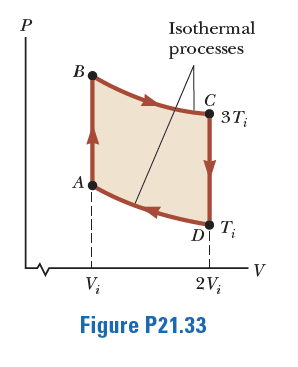In 1816, Robert Stirling, a Scottish clergyman, patented the Stirling engine, which has found a wide variety of applications ever since, including current use in solar energy collectors to transform sunlight into electricity. Fuel is burned externally to warm one of the engine’s two cylinders. A fixed quantity of inert gas moves cyclically between the cylinders, expanding in the hot one and contracting in the cold one. Image shown represents a model for its thermodynamic cycle. Consider n moles of an ideal monatomic gas being taken once through the cycle, consisting of two isothermal processes at temperatures 3Ti and Ti and two constant-volume processes. Let us find the efficiency of this engine. (a) Find the energy transferred by heat into the gas during the isovolumetric process AB. (b) Find the energy transferred by heat into the gas during the isothermal process BC. (c) Find the energy transferred by heat into the gas during the isovolumetric process CD. (d) Find the energy transferred by heat into the gas during the isothermal process DA. (e) Identify which of the results from parts (a) through (d) are positive and evaluate the energy input to the engine by heat. (f) From the first law of

Trending now
This is a popular solution!
Step by step
Solved in 9 steps with 9 images






